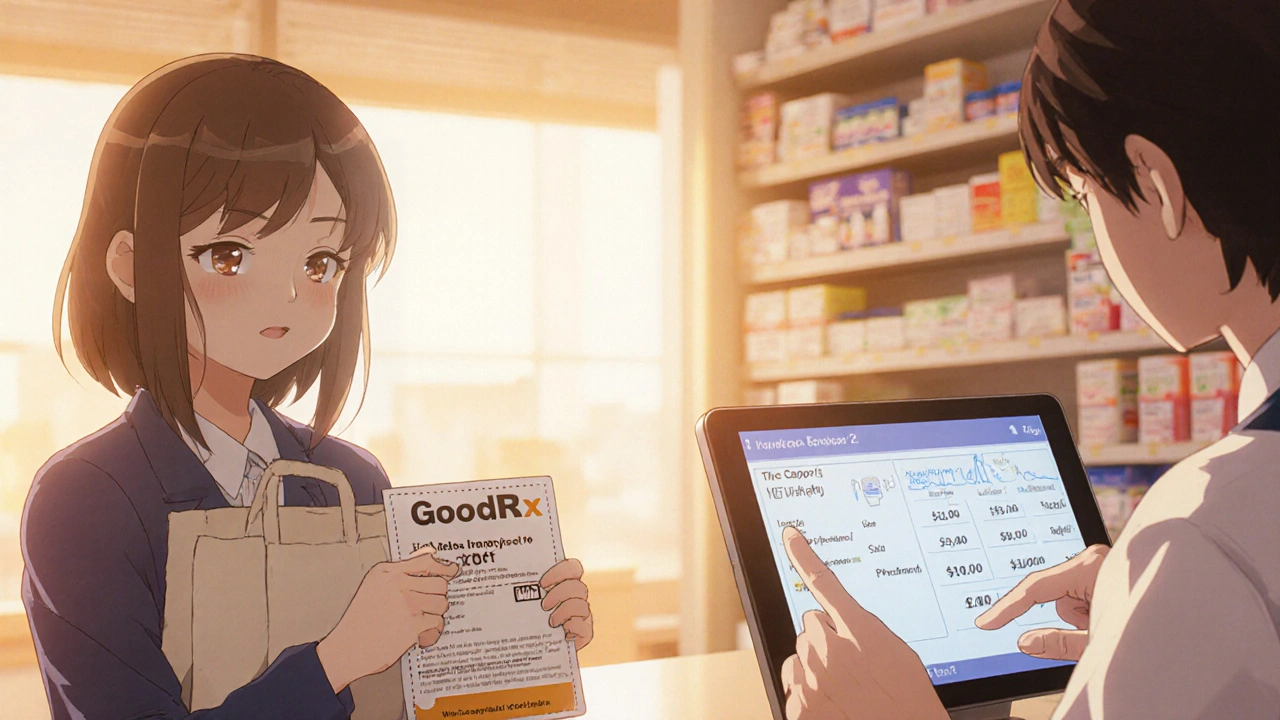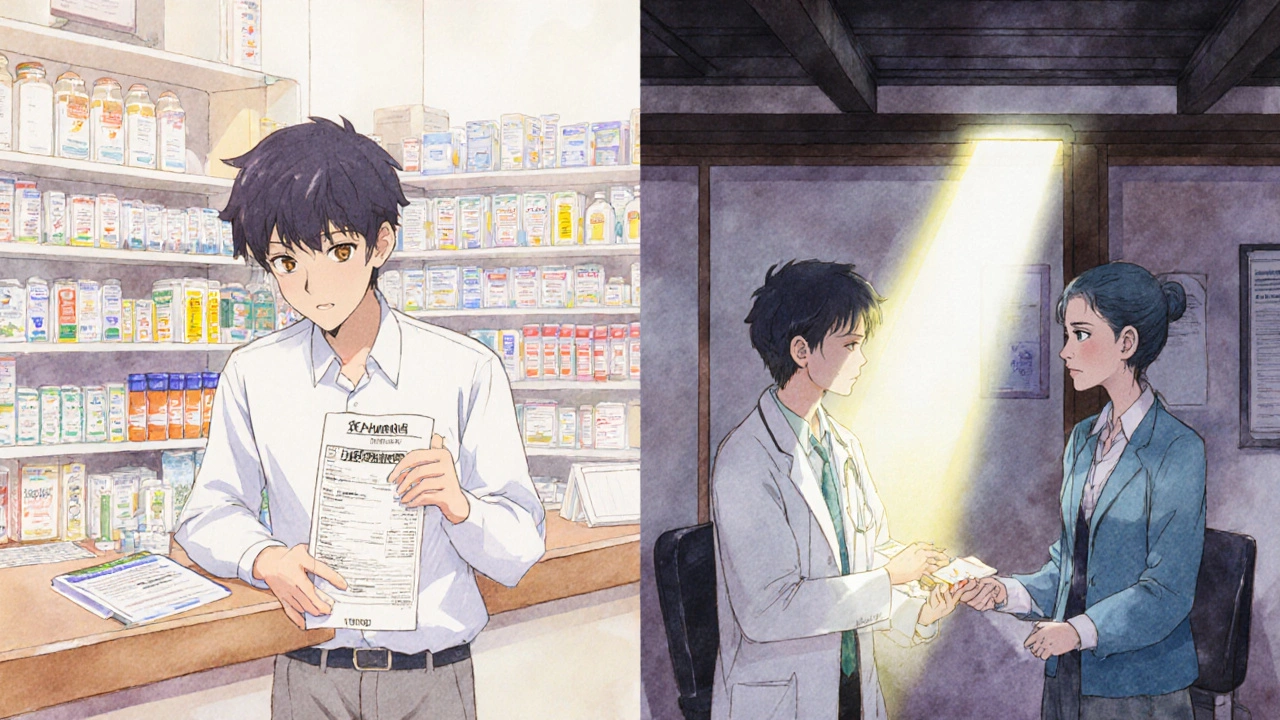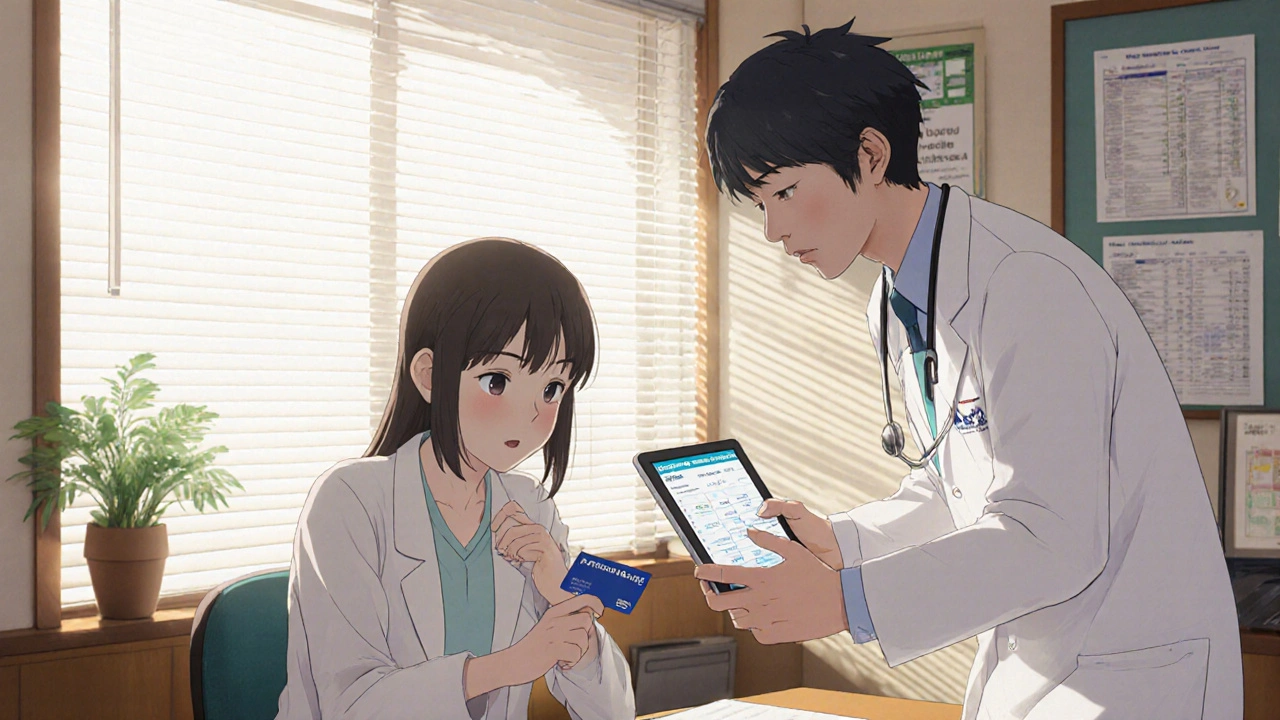Imagine this: you leave your doctor’s office with a new prescription, feeling hopeful about your treatment. Then, at the pharmacy counter, you’re hit with a $400 bill for a medication you thought was covered. You walk out empty-handed. This happens to 22% of people in the U.S. every year, according to GoodRx. It’s not just inconvenient-it’s dangerous. Skipping doses because of cost can make conditions worse, lead to hospital visits, and even shorten lives.
The good news? You don’t have to accept this. Talking about cost before you get the prescription is the single most effective way to avoid surprise bills. It’s not awkward. It’s smart. And it’s something you’re entitled to do-no matter what kind of insurance you have.
Why Cost Discussions Matter More Than Ever
In 2025, Medicare Part D changed dramatically. For the first time, there’s a hard cap on what beneficiaries pay out of pocket for prescriptions: $2,000 per year. That’s down from $8,000 in 2024. Insulin? Now it’s capped at $35 per month. These aren’t loopholes-they’re federal rules. But they only help if you know about them.
Commercial insurance hasn’t caught up. Most plans still have no annual cap on drug costs. Specialty drugs-like those for rheumatoid arthritis, multiple sclerosis, or cancer-can cost $500 to $1,500 per month, even with insurance. And if your plan doesn’t cover the drug, or puts it on the highest tier, you’re on your own.
Studies show that when patients talk about cost upfront, they’re 37% less likely to skip or cut back on meds. That’s not a small number. That’s life-changing.
What to Ask Your Doctor Before They Write the Script
Don’t wait until the prescription is printed. Bring up cost during the appointment. Here’s exactly what to say:
- “Is there a generic version of this drug?” Generics work the same as brand names but cost 80-85% less. For example, metformin (generic for Glucophage) costs $4-$10 a month. The brand can be $150+.
- “Is this drug on my insurance’s formulary?” A formulary is the list of drugs your plan covers. If it’s not on there, you’ll pay full price-or nothing at all.
- “What’s my out-of-pocket cost with my current plan?” Don’t rely on what the doctor thinks. Ask for the actual number. Some drugs have different copays depending on whether you’ve met your deductible.
- “Are there lower-cost alternatives that work just as well?” Sometimes, switching from a brand-name statin to a generic one can save $200/month. Your doctor might not know your plan’s details-but they can check.
- “Do you have samples?” Many doctors keep free samples in their office. Even a 30-day supply can help you decide if the medication works before you pay full price.
Pro tip: Bring your insurance card. Many doctors now use tools like Surescripts’ Real-Time Prescription Benefit (RTPB), which shows live cost data right in their electronic system. If your doctor doesn’t have it, ask if they can pull up your plan’s formulary online during the visit.
Know Your Insurance Plan Inside Out
Not all insurance is the same. Here’s how to decode yours:
- Medicare Part D: All plans must cover at least two drugs in each category. Use the Medicare Plan Finder (updated every October) to compare costs for your exact meds across plans. You can filter by monthly premium, deductible, and pharmacy network.
- Commercial Plans: Check your insurer’s website. Look for “Drug Formulary” or “Prescription Drug List.” Tiered systems are common: Tier 1 (generic) = $5-$15, Tier 2 (preferred brand) = $25-$50, Tier 3 (non-preferred) = $50-$100, Specialty = 25-33% coinsurance. Some plans have no cap-so a $1,200 drug could cost you $400.
- Medicaid: Typically has $1-$3 copays. But some drugs need prior authorization. If your doctor says “it’s covered,” ask if a prior auth is needed.
Also check your deductible status. If you’re early in the year (January-March), you might pay full price until you hit your deductible. A $480 deductible for a marketplace plan means you’re on the hook for the first $480 of prescriptions-no matter how many you fill.

Use Free Tools to Compare Prices
You don’t have to guess. There are tools built to help you:
- GoodRx: The most popular. Shows cash prices, coupon discounts, and sometimes even better prices than insurance. One user saved $287 on blood pressure meds by showing the pharmacist a GoodRx coupon. It’s free, no sign-up needed.
- SingleCare and RxSaver: Similar to GoodRx. Try all three. Prices vary by pharmacy.
- Your pharmacy’s app: CVS, Walgreens, and Rite Aid all have apps that show real-time copays. Enter your drug and insurance info-it’s instant.
- Medicare Prescription Payment Plan: Starting in 2025, Medicare beneficiaries can pay for prescriptions in monthly installments. No large bills at the counter. But enroll early-waiting until November means you can’t spread payments across the full year.
Pro tip: Always ask the pharmacist: “Can I use this coupon even though I have insurance?” Sometimes, the cash price with a coupon is cheaper than your insurance copay.
What to Do If the Drug Isn’t Covered
If your drug isn’t on the formulary, don’t give up. Here’s your roadmap:
- Ask your doctor for a prior authorization. This is a formal request to your insurer to cover a drug that’s not on the list. Doctors do this all the time. In fact, 68% of specialty drugs require it.
- Ask if there’s a therapeutic equivalent. Maybe another drug in the same class works just as well and is covered.
- Check for patient assistance programs. Most drugmakers offer free or low-cost meds to people who qualify based on income. Go to NeedyMeds.org or call the manufacturer directly.
- Call your insurer’s customer service with the NDC number (found on the prescription label). Ask: “What’s my exact out-of-pocket cost for this drug at my local pharmacy?” Average wait time is 14-18 minutes, but it’s worth it.
According to the Patient Advocate Foundation, 43% of coverage denials are resolved through prior authorization-once the doctor submits the paperwork.

Timing Is Everything
Don’t wait until you’re out of meds to talk about cost.
- Annual Enrollment Period (October 15-December 7): If you’re on Medicare, this is your chance to switch plans for better drug coverage. Use the Plan Finder tool to compare your top 5 meds across all plans.
- Before your doctor’s appointment: Review your plan’s formulary and note your deductible status. Bring a list of your meds and their costs.
- At the pharmacy: If you’re surprised by the price, ask if they can check another pharmacy in your network. Prices vary wildly-even within the same chain.
And remember: if you’re paying more than 2% of your monthly income for a single prescription, the American Pharmacists Association says you should speak up. That’s $60 on a $3,000 monthly income. If it’s costing you that much, there’s almost always a better option.
Real Stories, Real Savings
One woman in Ohio, ‘MedicareMom2023,’ shared on Reddit that she avoided a $1,200 monthly bill by checking her plan’s formulary before her doctor’s visit. She found a generic alternative that was covered and saved over $14,000 a year.
Another patient in Texas got a new diabetes drug prescribed. The copay was $350. He asked his pharmacist about GoodRx. The cash price was $48. He used the coupon and paid $48. He didn’t even use his insurance.
These aren’t rare cases. They’re the result of one simple habit: asking before you pay.
Final Checklist: Before You Leave the Office
Before you walk out of your doctor’s office, make sure you’ve checked these boxes:
- ✅ Is there a generic version?
- ✅ Is this drug on my plan’s formulary?
- ✅ What’s my exact out-of-pocket cost?
- ✅ Are there lower-cost alternatives?
- ✅ Do you have samples?
- ✅ Can you check the cost in real time using your EHR system?
If you can answer all of these, you’re ahead of 85% of patients. You’re not just managing your health-you’re managing your money too.
What if my insurance doesn’t cover my medication at all?
First, ask your doctor if there’s a similar drug that’s covered. If not, ask them to file a prior authorization request with your insurer. You can also check patient assistance programs through NeedyMeds.org or the drug manufacturer’s website. Many companies offer free or discounted meds to people who qualify based on income.
Can I use GoodRx instead of my insurance?
Yes, you can. Sometimes the cash price with a GoodRx coupon is cheaper than your insurance copay. Always ask the pharmacist to compare both options. You can’t use both at the same time, but you can choose the lower price.
Why does my prescription cost more at some pharmacies than others?
Pharmacies set their own cash prices, even if they’re in the same network. A drug might cost $120 at Walgreens but $75 at CVS. Use GoodRx or your insurer’s app to compare prices before you fill it. Some pharmacies even offer discount programs for cash-paying customers.
Does the Inflation Reduction Act help people with private insurance?
Not directly. The $2,000 out-of-pocket cap and $35 insulin limit only apply to Medicare Part D. But the law pushed drugmakers to negotiate prices, which may lead to lower list prices over time. Some private insurers are starting to adopt similar caps voluntarily.
When is the best time of year to switch my prescription drug plan?
For Medicare, the Annual Enrollment Period is October 15 to December 7. That’s when you can switch plans for coverage starting January 1. For private insurance, you usually can only switch during open enrollment (typically November) or after a qualifying life event like losing a job or moving.
Don’t let a surprise bill stop you from getting the care you need. Talking about cost isn’t a burden-it’s a right. And with the tools and knowledge available today, you have more power than ever to take control.


Comments
This article literally saved me last month. I was about to fill a $300/month script for my thyroid meds until I asked my doctor about generics-turned out there was a $12 version covered 100%. I cried in the parking lot. No one talks about this stuff enough.
One must lament the abysmal state of pharmaceutical economics in the United States-a nation which, despite its technological prowess, continues to permit the commodification of human health with such brazen disregard for equity. The very notion that a citizen must negotiate for life-sustaining medication like a haggler at a bazaar is not merely inconvenient-it is an affront to civilised society.
goodrx is a game changer 😍 i paid $8 for my antidepressant last week instead of $140. just showed the coupon and the pharmacist went ‘oh yeah we can do that’ and didn’t even blink. do it. no shame.
Let me tell you something-this is not just about insurance, or coupons, or generics-it’s about dignity. When you’re forced to choose between food and your medication, you’re not just poor-you’re systemically abandoned. And yes, the U.S. is the only developed country where this happens. We have the resources. We have the knowledge. We just lack the moral courage.
Most people who use GoodRx don’t even understand how it works. You’re not saving money-you’re just avoiding your insurance’s negotiated rates, which means your insurer doesn’t count it toward your deductible. You’re paying more long-term. And if you’re on Medicare, you’re not even helping the system. This advice is dangerously naive.
Hey, I know you’re trying to help, but I’ve been on 5 different meds in the last 2 years and every time I ask about cost, my doctor just says ‘oh we’ll figure it out’ and then I get the bill. I don’t think asking is enough. There needs to be a law that forces doctors to show real-time prices before writing the script. Not optional. Mandatory.
This is one of the most important pieces of health advice I’ve read in years. The checklist at the end? Print it. Tape it to your bathroom mirror. Share it with your parents. Your sibling. Your neighbor who just got diagnosed. This isn’t just about money-it’s about survival. And if you’re reading this and you’ve never asked your doctor about cost? You’re not alone. But you’re also not powerless anymore.
u think this is bad wait till u see india where u pay 1000rs for a month of med and still get fake pills from the pharmacy lol. at least in usa u have goodrx and stuff. we just pray and hope the doctor is legit. america u lucky u r
This article assumes everyone has a doctor who listens. What about the 40% of Americans who can’t afford primary care? Or those who only see a PA in a 10-minute urgent care slot? Asking questions doesn’t help if the system is designed to silence you.
Just used GoodRx for my dad’s blood thinner. Saved him $180. I didn’t even know you could do that. I thought insurance always had the best price. So easy. Why didn’t anyone tell me this before?
if you’re on medicaid and they say ‘we don’t cover this’ ask for the formulary list. they’ll give it to you. then go to nee demeds.org and look up the drug. 9 times outta 10 there’s a free program. i got my insulin free for 6 months that way. no joke. it’s out there. just gotta look
So let me get this straight-you’re telling people to ‘ask their doctor’ while ignoring that 80% of prescriptions are written by PAs and NPs who aren’t trained in cost navigation? This advice is performative. It puts the burden on the patient while the system stays broken. You’re not helping. You’re distracting.
My doctor told me to use GoodRx. I did. It was cheaper. Then my insurance sent me a letter saying they ‘disapproved’ the claim and I had to pay $120 in penalties because I didn’t use my insurance. So now I’m paying more. Thanks for the advice.